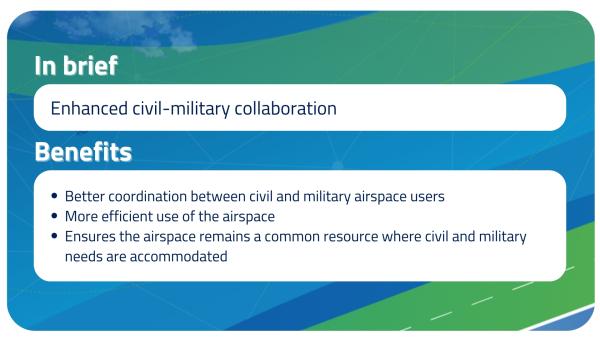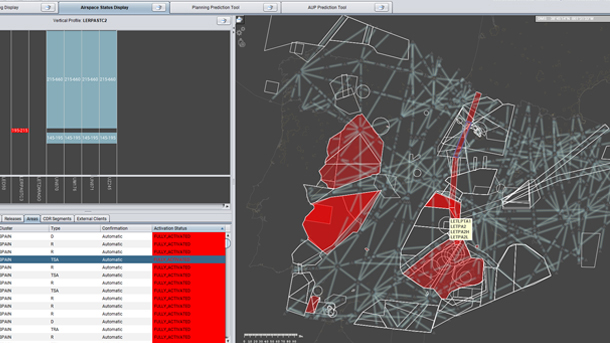Enhanced civil / military cooperation in air traffic management
SESAR is delivering solutions that help maximise airspace capacity, allowing military and civil air traffic to share the skies while ensuring the safety, security and efficiency of all users.
Europe’s airspace is a finite resource, one that must accommodate both civil and military users. Managing this shared space efficiently and safely is no small feat, particularly given the differing operational requirements of civil and military aviation. By delivering a range of operational and technical solutions designed to ensure more flexible cooperation between these stakeholders, SESAR is helping to ensure that the airspace is used to its fullest extent.

While Europe’s various commercial airlines collectively operate a staggering 7 million commercial flights every year, Europe’s biggest airspace user is actually the military, which operates over 150,000 flights annually(1). Add these figures up and what you get is a big challenge for air traffic control, which must provide these very different users with safe access to the very same airspace and often at the very same time.
Specifically, air traffic control must balance the need for secure military operations without neglecting the needs of civil aviation. To make things even more complicated, due to the nature of military flights, they are often required to do so at very short notice.
What’s needed is an interoperable air traffic management system for civil and military users – which is exactly what SESAR delivered.
Working in close collaboration with the European Defence Agency (EDA) and other military stakeholders, SESAR has developed operational and technical solutions that allow for more flexible and agile civil-military cooperation – a cooperation that ensures all users can access the same airspace in a safe and efficient manner.
The solution
SESAR Solution #31, ‘Variable profile military reserved areas and enhanced civil-military collaboration’, focuses on improving the dynamic airspace management process. It aims to enhance the flexible use of airspace by facilitating better coordination between civil and military airspace users(2).
Key components of the solution include:
Flexible use of airspace (FUA)
FUA is an air traffic management concept that allows for the dynamic allocation and use of airspace based on real-time needs and conditions. The objective is to enhance the efficiency of airspace utilisation while always maintaining safety and minimising the environmental impact.
FUA enables both civil and military aviation to share the same airspace without the rigid segregation that was previously the norm.
Interoperability of systems in civil-military data exchange
Another crucial aspect of modern air traffic management, interoperability allows for the seamless exchange of real-time information between civil and military air traffic control units. This exchange includes data on airspace status, flight plans and aircraft positions.
This level of interoperability ensures that both civil and military air traffic management systems can effectively communicate, share data and coordinate operations to optimise airspace usage, enhance safety and security and improve efficiency.
Collaborative decision making (CDM)
CDM is essential for balancing the needs of civil aviation and military operations and involves the real-time sharing of information and data between civil and military air traffic control units. This process reduces the potential for conflicts and enhances overall air traffic efficiency.
The results
The SESAR Solution helps improve civil–military coordination at the network level, providing shareable data on mission trajectories that enable better traffic prediction and airspace information exchange.
With solutions like these, civil and military stakeholders can collaborate to develop coordinated strategies that address each other's requirements and constraints. For example, military training zones can be temporarily opened to civil air traffic when not in use, and civil flights can be rerouted to accommodate military operations when necessary.
This level of flexibility and coordination helps minimise delays, reduce fuel consumption and lower emissions by enabling more direct and optimal flight paths.
The details
- Considerable progress has been made in respect to civil-military cooperation, with both stakeholders sharing safety and security responsibilities. SESAR deployment, for instance, has provided opportunities for the military to obtain EU co-funding, which has enhanced ATM technologies and helped improve European security.
- To ensure that the needs of military aviation users are understood and taken into account, European Member States entrusted the EDA with facilitating coordination within the military community and channelling the coordinated input of the armed forces as it works closely with SESAR.
- SESAR deployment also involved several military stakeholders, including the Italian, Portuguese and Spanish air forces, the French military control, and the NATO AEW&C Programme Management Agency (NAPMA)*.
In action
Deployment projects across Europe showcase how these SESAR innovations are being implemented.
A good example of this work is the launch of the local and sub-regional airspace management support system (LARA) software package. LARA supports and enhances the airspace management process according to advanced flexible use of airspace principles. This enables collaborative decision-making and provides live situational awareness to civil and military partners.
Through SESAR, the LARA system has been deployed by such European air navigation service providers as ENAIRE(3), ENAV(4), NAV Portugal(5), EANS(6) and skeyes(7).
Other examples of successfully completed deployment projects within the military framework include:
- System upgrades to enhance aeronautical data quality and exchange
- The upgrade of military control and reporting centres (CRC) for civil-military interoperability(8)
- Upgrading of aeronautical data quality and exchange
- Aircraft such as the Spanish Air Force’s Falcon 900 have been equipped with the necessary capabilities to operate seamlessly within the European air traffic management network(9)
Collaboration between civil and military stakeholders continues to evolve, with ongoing innovation focused on advanced tools like artificial intelligence to identify and resolve air traffic hotspots. These efforts highlight how the deployment of SESAR solutions is driving safer, more efficient and environmentally sustainable air traffic management across Europe.
* NAPMA is composed of 16 full-member countries: Belgium, Czech Republic, Denmark, Germany, Greece, Hungary, Italy, Luxembourg, the Netherlands, Norway, Poland, Portugal, Romania, Spain, Turkey and the USA.


References
- SESAR Joint Undertaking | SESAR JU Flagships
- Sol31 01 CN Solution 31 VPA and enhanced civil-military collaboration.pdf
- SESAR Deployment Manager – Projects – Deployment of LARA System in Spain | SESAR DM
- Projects - ASM - LARA Enhancement - Implementation in Italy | SESAR DM
- Projects - Initial ASM tool to support AFUA for NAV Portugal | SESAR DM
- eurocontrol-lssip-2023-estonia_0.pdf
- Projects - LARA integration in CANAC 2 | SESAR DM
- Projects - Upgrade of French Military Control and Reporting Centres (CRC) for civil- military interoperability | SESAR DM
- Projects - FALCON 900 compliance with Air Ground ATN VDL2 Data Link (AIR) | SESAR DM

